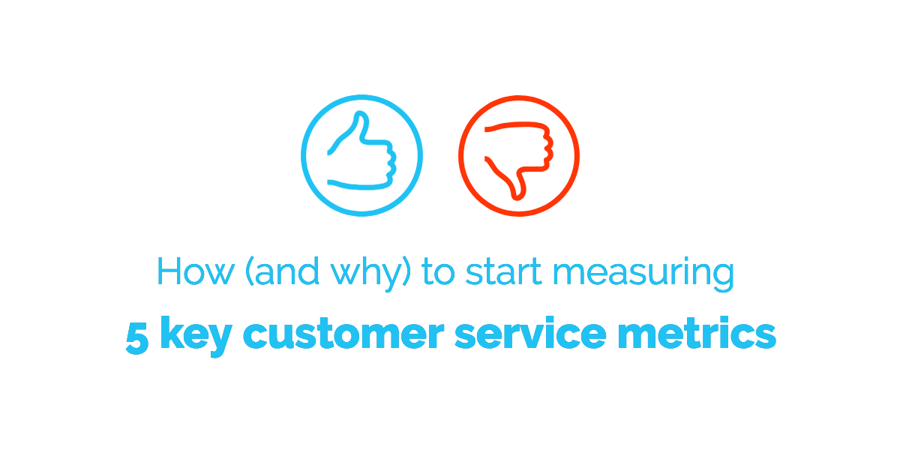How (and why) to start measuring 5 key customer service metrics


These days, customer loyalty is more valuable than ever. Because customers remember the service your company provides a lot longer than they remember the price they paid, it’s crucial to create a positive customer experience every time. Delivering great customer support can help you earn repeat business and grow your company in a plethora of ways.
But tracking important customer service metrics for your business can be intimidating, especially if you’re just starting to build out your customer service department. Although metric tracking is an essential part of company success, leaders may struggle when it comes to measuring the right numbers, and they may not even know where to start.
Let’s take a look at why you should track customer service metrics and five key data points to measure for success.
Why should you report metrics?
Tracking customer service metrics helps you measure performance and clarify focus. They are key guides to measure whether your customer service team is living up to customer expectations. Reporting the right metrics can also help your organization stay consistent and proactive without the need to fight fires when it’s too late.
When you invest in great customer support experience, you build a lasting impact on customer loyalty, reduce churn, boost retention and referrals, and maximize your potential for better customer support.
But there isn’t one metric (or combination of metrics) to rule them all. Every business and organization lives by a set of different standards and rules. The definition of success should be specific to your company. When you’re clear about what and why you’re reporting, you can make informed decisions to improve your company’s bottom line.
What makes a good metric?
We’ve outlined five key characteristics of effective metrics for customer service. A good metric needs to be:
-
Meaningful: Metrics should relate to what your organization aims to achieve.
-
Actionable: Metrics should measure data that your team can have an impact towards, instead of leveraging vanity numbers that have no value.
-
Authentic: Metrics should tell the true story. Numbers don’t lie, and metrics shouldn’t either.
-
Contextualized: Data in isolation can be stripped of meaning. Providing context behind numbers allows you to spot trends and make proactive decisions within a bigger picture.
-
Consistent: Ensuring consistency allows you to gather useful insights based on historical trends.
With these characteristics in mind, let’s get started! Here are 5 customer service metrics to measure when you’re building out your customer service department:
Churn rate
Definition: The churn rate is the percentage of customers (or the total number of customers) who discontinue their subscription to a service.
How it’s used: Calculating the churn rate measures the company’s health and long-term prospects, calculates customer lifetime value, forecasts a business’s performance, and tracks customer retention improvements over time.
How it’s calculated: (Number of customers lost) / (Original number of customers) = churn rate.
Why it’s important: The churn rate evaluates the health of your business. It costs more to close a new customer than to retain an existing customer, so a high churn rate will indicate a lot of additional expense.
Net Promoter Score (NPS)
Definition: A net promoter score is a measure of how likely your customers would recommend your organization to someone else, expressed as a percentage.
How it’s used: Numerical scores categorize each customer. Detractors have scores from 0-6, passives have scores from 7-8, and promoters have scores from 9-10 range. The larger the difference between the percentage of promoters and detractors, the higher your company’s NPS.
How it’s calculated: % of promoters - % of detractors = NPS.
Why it’s important: Calculating the NPS helps businesses evaluate customer loyalty. It also helps assess the likelihood of customer churn.
Customer Satisfaction Survey (CSAT)
Definition: A CSAT is a measure of your customer’s satisfaction with your service, expressed as a percentage.
How it’s used: This score is often determined by asking customers a question, a set of queries, or a long survey to assess their experience.
How it’s calculated: (Number of satisfied customers) / Number of survey responses) x 100 = CSAT.
Why it’s important: With customized survey questions, you can pinpoint what’s working and not working to find the best avenues for enhancing your customer’s experience. You can also tie CSATs with key moments in the process and measure the effectiveness of user onboarding or the customer resolution process.
Customer Effort Score (CES)
Definition: CES measures the ease of a customer’s experience with a company.
How it’s used: This score is used to gauge the ease of the customer’s experience. By using a five-point scale of “Very Easy” to “Very Difficult”, the score evaluates the amount of effort it takes for customers to use a product. It’s best to send out CES surveys after specific service touchpoints to ensure real-time feedback.
How it’s calculated: % easy - % difficult = CES
Why it’s important: Knowing your CES gives you the opportunity to uncover bottlenecks and mitigate issues before the problem gets worse or customers stop using your service or product. It’s also a strong predictor of future purchase behavior.
Knowledge base visits
Definition: The knowledge base visits from your top articles or top searches assess the effectiveness of your resources.
How it’s used: If you have a resources page or helpful tools on your website, you can measure its effectiveness to understand how well this is helping customers solve their problems. You can look at the number of views vs. submitted cases, bounce rate vs. time on page, and product users vs. support requests.
How it’s calculated: Count the total number of your chosen metrics and compare!
Why it’s important: Research shows that customers prefer to help themselves with available resources rather than contacting support. A valuable knowledge base (e.g. a blog, videos, or ebooks) can reduce repetitive inquiries and allows your staff to focus on more complex or high-involved problems.
Good customer service is a powerful marketing and sales strategy.
Tackling the numbers game can be daunting. But with some support and preparation along the way, your team will be able to take action based on useful data. By constantly learning, implementing new things, and evolving to deliver a great customer experience, you can grow your business.





